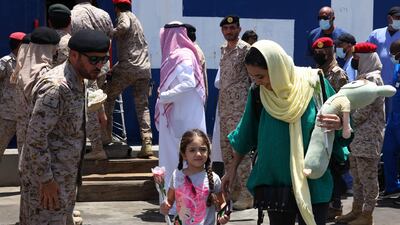Follow the latest news from the Sudan crisis here
Iran has thanked Saudi Arabia for helping its citizens escape the conflict in Sudan after dozens arrived by boat in Jeddah.
The 65 Iranians were among about 1,900 people ferried to safety from Port Sudan on Saturday as fighting between rival Sudanese forces entered a third week.
"We have seen effective co-operation and assistance from Saudi Arabia that deserves appreciation and gratitude," Iranian Foreign Ministry spokesman Nasser Kanaani said.
Mr Kanaani said the ministry had been pursuing plans since the violence broke out on April 15 to bring back the 65 citizens living in Sudan.
After the necessary arrangements, the Iranians were evacuated safely from Sudan’s capital Khartoum and transferred to Port Sudan, from where they sailed to Jeddah, he said.
He said plans had been made to bring the Iranians home from Saudi Arabia.
Saudi Arabia and Iran agreed last month to restore ties seven years after breaking off diplomatic relations. They are working to reopen their respective embassies and to resume flights between the two countries.
Hassan Zarnegar Abarghoui, one of four Iranian diplomats waiting to receive the citizens at the King Faisal Naval Base in Jeddah, said his government was grateful for the "humanitarian co-operation" shown by the Saudi authorities.
Merhdad Malekzadh, a 28-year-old Iranian who had lived in Khartoum since he was a child, said no one had expected the fighting to become so intense, and his escape had also been a surprise.
"Because of our nationality, we had never imagined we would come to Saudi Arabia when we were evacuated," said Mr Malekzadh, whose family runs an oil lubricant business in the Sudanese capital.
"Fortunately, they really helped us. They put their differences aside and worked together. They saved lives."
With Saturday's evacuation, Saudi Arabia has brought nearly 4,900 people from Sudan, the official Saudi Press Agency said. They include 139 citizens of the kingdom and 4,738 people from 96 other countries.
With reporting from AFP
Company%20Profile
%3Cp%3E%3Cstrong%3ECompany%20name%3A%3C%2Fstrong%3E%20Cargoz%3Cbr%3E%3Cstrong%3EDate%20started%3A%3C%2Fstrong%3E%20January%202022%3Cbr%3E%3Cstrong%3EFounders%3A%3C%2Fstrong%3E%20Premlal%20Pullisserry%20and%20Lijo%20Antony%3Cbr%3E%3Cstrong%3EBased%3A%3C%2Fstrong%3E%20Dubai%3Cbr%3E%3Cstrong%3ENumber%20of%20staff%3A%3C%2Fstrong%3E%2030%3Cbr%3E%3Cstrong%3EInvestment%20stage%3A%3C%2Fstrong%3E%20Seed%3C%2Fp%3E%0A
Drishyam 2
Directed by: Jeethu Joseph
Starring: Mohanlal, Meena, Ansiba, Murali Gopy
Rating: 4 stars
UAE currency: the story behind the money in your pockets
Race card
6.30pm: Handicap (TB) $68,000 (Dirt) 1,200m
7.05pm: Meydan Cup – Listed Handicap (TB) $88,000 (Turf) 2,810m
7.40pm: UAE 2000 Guineas – Group 3 (TB) $125,000 (D) 1,600m
8.15pm: Firebreak Stakes – Group 3 (TB) $130,000 (D) 1,600m
9.50pm: Meydan Classic – Conditions (TB) $$50,000 (T) 1,400m
9.25pm: Dubai Sprint – Listed Handicap (TB) $88,000 (T) 1,200m
The biog
Alwyn Stephen says much of his success is a result of taking an educated chance on business decisions.
His advice to anyone starting out in business is to have no fear as life is about taking on challenges.
“If you have the ambition and dream of something, follow that dream, be positive, determined and set goals.
"Nothing and no-one can stop you from succeeding with the right work application, and a little bit of luck along the way.”
Mr Stephen sells his luxury fragrances at selected perfumeries around the UAE, including the House of Niche Boutique in Al Seef.
He relaxes by spending time with his family at home, and enjoying his wife’s India cooking.
Infiniti QX80 specs
Engine: twin-turbocharged 3.5-liter V6
Power: 450hp
Torque: 700Nm
Price: From Dh450,000, Autograph model from Dh510,000
Available: Now
Terror attacks in Paris, November 13, 2015
- At 9.16pm, three suicide attackers killed one person outside the Atade de France during a foootball match between France and Germany
- At 9.25pm, three attackers opened fire on restaurants and cafes over 20 minutes, killing 39 people
- Shortly after 9.40pm, three other attackers launched a three-hour raid on the Bataclan, in which 1,500 people had gathered to watch a rock concert. In total, 90 people were killed
- Salah Abdeslam, the only survivor of the terrorists, did not directly participate in the attacks, thought to be due to a technical glitch in his suicide vest
- He fled to Belgium and was involved in attacks on Brussels in March 2016. He is serving a life sentence in France
GIANT REVIEW
Starring: Amir El-Masry, Pierce Brosnan
Director: Athale
Rating: 4/5
COMPANY%20PROFILE
%3Cp%3E%3Cstrong%3EName%3A%20%3C%2Fstrong%3EShaffra%3Cbr%3E%3Cstrong%3EStarted%3A%20%3C%2Fstrong%3E2023%3Cbr%3E%3Cstrong%3EBased%3A%20%3C%2Fstrong%3EDIFC%20Innovation%20Hub%3Cbr%3E%3Cstrong%3ESector%3A%20%3C%2Fstrong%3Emetaverse-as-a-Service%20(MaaS)%3Cbr%3E%3Cstrong%3EInvestment%3A%20%3C%2Fstrong%3Ecurrently%20closing%20%241.5%20million%20seed%20round%3Cbr%3E%3Cstrong%3EInvestment%20stage%3A%20%3C%2Fstrong%3Epre-seed%3Cbr%3E%3Cstrong%3EInvestors%3A%20%3C%2Fstrong%3EFlat6Labs%20Abu%20Dhabi%20and%20different%20PCs%20and%20angel%20investors%20from%20Saudi%20Arabia%3Cbr%3E%3Cstrong%3ENumber%20of%20staff%3A%20%3C%2Fstrong%3Enine%3C%2Fp%3E%0A

